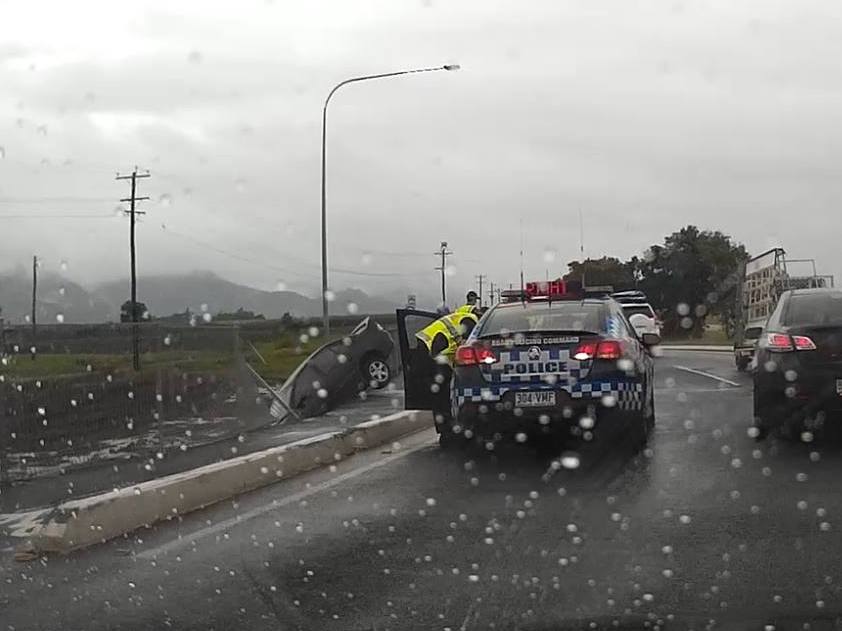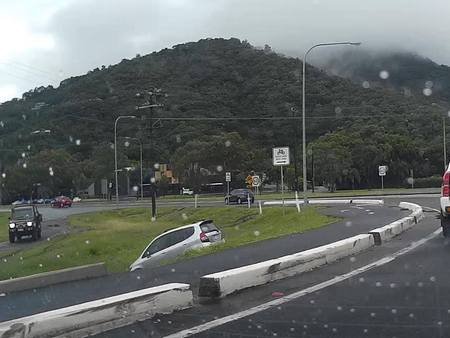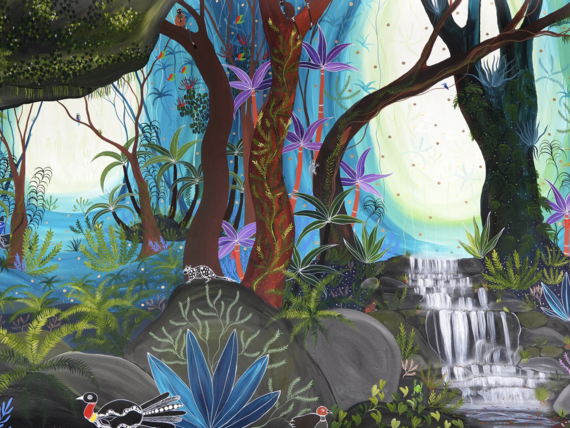Are we the world's worst wet weather drivers?
Seriously people: just slow down when the roads get wet in the tropical north, for everyone's sake.

Is it just us, or do Cairns drivers put their foot down and start driving crazier the second they see the first drop of rain hit our roads?
OK, so that's a little unfair to the vast majority who do the right thing.
But the recent downpour after a dry spell has seen a predictable rise in single vehicle crashes.
Social media has responded with photos and comments about terrible driving on our roads, particularly on those dreaded roundabouts on the Northern Beaches.

Sergeant Marc Rodgers works in the traffic branch at Cairns Police, and he sees the best and worst behaviour of local drivers.
While cars skidding off the road at roundabouts or hitting a ditch may not land the driver in hospital or cause serious injury, Sgt Rodgers points out they could easily turn fatal.
"There’s often very little difference in what's a single vehicle crash and what's a double fatality," Sgt Rodgers said.
"Maybe you're driving along and you look down to adjust your stereo in the dry and that's OK, but if you do that in the wet it can end up being a very different outcome.
"A lot of people are doing things right in the wet, but we've all got to adjust our driving to the conditions. We can't become complacent at any time, but especially in the wet."
To remind drivers about some of the basics when it comes to driving in the wet, Tropic Now asked Sgt Rodgers for some advice.
So here are the top 7 tips from Sgt Rodgers when it comes to driving in the wet:
1. Drive to the conditions
This one seems obvious, but it's the first thing overlooked.
Sgt Rodgers: "We call it 'continual assessment' of the road and other road users. Don’t get comfortable in your driving. Even though you've driven that certain way every day you've got to modify your driving according to the conditions. Don't become complacent."
2. Speed limit signs show the maximum speed
That 80km/h sign doesn't mean you always have to drive at 80km/h.
Sgt Rodgers: "It may be fine to travel at 60km/h in a 60 zone when it's dry, but in the wet you might have to drive at 50 or 40 km/h. The speed limit shown is a maximum speed limit for when conditions are perfect. You don't have to travel the maximum in the wet."
3. Increase the gap between the next car
Wet roads = less time to stop.
Sgt Rodgers: "In the wet you've got to increase the gap between you and driver in front because you have a reduced capacity to stop. This is even more important when you consider factors like the behaviour of the driver in front, distractions, tyre treads and pooled water or oily patches on the road."
4. Check your tyre tread
Yes, the quality and age of your tyre tread makes a big difference.
Sgt Rodgers: "Tyre tread is designed to disperse water. If you have no tread, you increase the likelihood of aqua-planing and you increase the stopping time. Check your treads and tyres regularly."
5. Tourists may struggle with local conditions
If you think Cairns drivers are bad, consider how a tourist who has never driven on our roads will handle wet conditions.
Sgt Rodgers: "You've got to take into consideration the experience of other road users in wet weather. Just because we drive in the wet all the time doesn’t mean a visitor or tourist knows what they’re doing in the wet. And if locals have problems on roundabouts, imagine how some tourists might handle them."
6. Plan your journey if it's raining
A failure to plan could mean a plan for crashing.
Sgt Rodgers: "If you know the roads or wet or it was raining the night before, start your journey earlier than normal, even if it's by ten minutes. If you're running late or there's lots of traffic, that's when you create pressure for yourself and you can make mistakes."
7. Don't text and drive. Ever.
Despite the graphic advertising and government campaigns, the message still isn't getting through.
Sgt Rodgers: "You see it all the time when you pull up to the lights and people reach for their phones even if they're stopped for 5 seconds. Texting while driving obviously wasn't an issue ten years ago, but now it's so common and the message still isn't getting through. Just don't do it."








